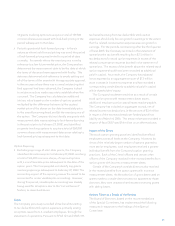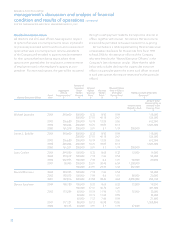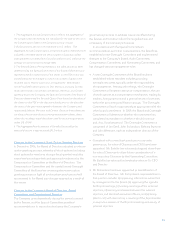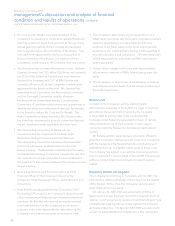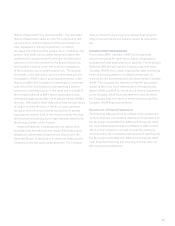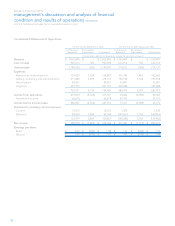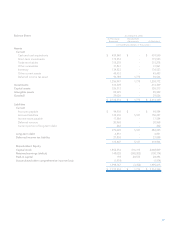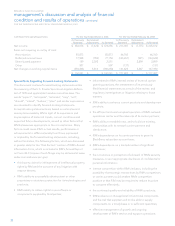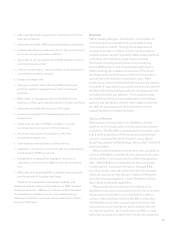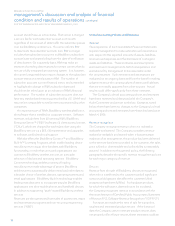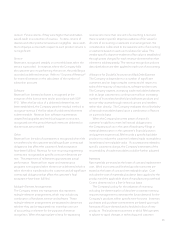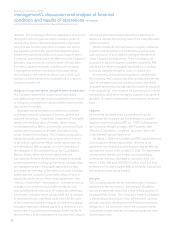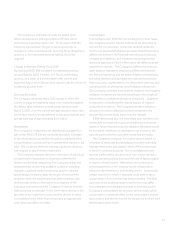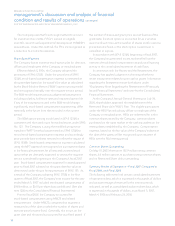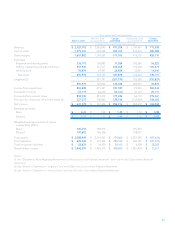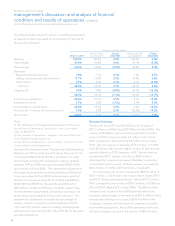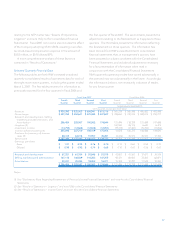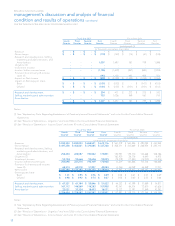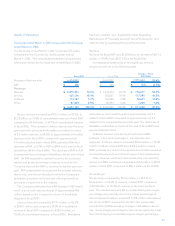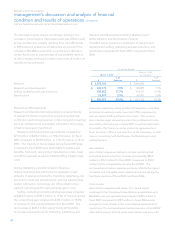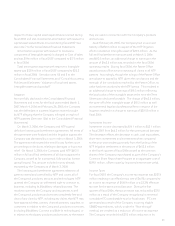Blackberry 2007 Annual Report Download - page 33
Download and view the complete annual report
Please find page 33 of the 2007 Blackberry annual report below. You can navigate through the pages in the report by either clicking on the pages listed below, or by using the keyword search tool below to find specific information within the annual report.31
revised. Future returns, if they were higher than estimated,
would result in a reduction of revenue. To date, returns of
devices and other products have been negligible. As a result,
the Company’s accrual with respect to such product returns is
not significant.
Service
Revenue is recognized rateably on a monthly basis when the
service is provided. In instances where the Company bills
the customer prior to performing the service, the prebilling is
recorded as deferred revenue. Refer to “Sources of Revenue”
for more information on the calculation of the number of
subscriber accounts.
Software
Revenue from licensed software is recognized at the
inception of the licence term and in accordance with SOP
97-2. When the fair value of a delivered element has not
been established, the Company uses the residual method to
recognize revenue if the fair value of undelivered elements
is determinable. Revenue from software maintenance,
unspecified upgrades and technical support contracts is
recognized over the period that such items are delivered or
that services are provided.
Other
Revenue from the sale of accessories is recognized when title
is transferred to the customer and all significant contractual
obligations that affect the customer’s final acceptance
have been fulfilled. Revenue for non-recurring engineering
contracts is recognized as specific contract milestones are
met. The attainment of milestones approximates actual
performance. Revenue from repair and maintenance
programs is recognized when the service is delivered which is
when the title is transferred to the customer and all significant
contractual obligations that affect the customer’s final
acceptance have been fulfilled.
Multiple-Element Arrangements
The Company enters into transactions that represent
multiple-element arrangements, which may include any
combination of hardware, service and software. These
multiple-element arrangements are assessed to determine
whether they can be separated into more than one unit
of accounting or element for the purpose of revenue
recognition. When the appropriate criteria for separating
revenue into more than one unit of accounting is met and
there is vendor specific objective evidence of fair value for
all units of accounting or elements in an arrangement, the
consideration is allocated to the separate units of accounting
or elements based on each unit’s relative fair value. This
vendor specific objective evidence of fair value is established
through prices charged for each revenue element when that
element is sold separately. The revenue recognition policies
described above are then applied to each unit of accounting.
Allowance for Doubtful Accounts and Bad Debt Expense
The Company is dependent on a number of significant
customers and on large complex contracts with respect to
sales of the majority of its products, software and services.
The Company expects increasing trade receivables balances
with its large customers to continue as it sells an increasing
number of its wireless handheld and software products and
service relay access through network carriers and resellers
rather than directly. The Company evaluates the collectibility
of its trade receivables based upon a combination of factors
on a periodic basis.
When the Company becomes aware of a specific
customer’s inability to meet its financial obligations to
the Company (such as in the case of bankruptcy filings or
material deterioration in the customer’s financial position
and payment experience), RIM records a specific bad debt
provision to reduce the customer’s related trade receivable to
its estimated net realizable value. If circumstances related to
specific customers change, the Company’s estimates of the
recoverability of trade receivables could be further adjusted.
Inventory
Raw materials are stated at the lower of cost and replacement
cost. Work in process and finished goods inventories are
stated at the lower of cost and net realizable value. Cost
includes the cost of materials plus direct labor applied to the
product and the applicable share of manufacturing overhead.
Cost is determined on a first-in-first-out basis.
The Company’s policy for the valuation of inventory,
including the determination of obsolete or excess inventory,
requires management to estimate the future demand for the
Company’s products within specific time horizons. Inventory
purchases and purchase commitments are based upon such
forecasts of future demand and scheduled rollout of new
products. The business environment in which RIM operates
is subject to rapid changes in technology and customer


